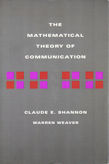From the Preface:
The first paper [Weaver, Some Recent Contributions to the Mathematical Theory of Communication] has not previously been printed in its present form, although a condensation appeared in Scientific American, July, 1949. In part, it consists of an expository introduction to the panoramic view of the field before entering into the more mathematical aspects. In addition, some ideas are suggested for broader application of the fundamental principles of communication theory.
The second paper [Shannon, The Mathematical Theory of Communication] is reprinted from the Bell System Technical Journal, July and October, 1948, with no changes except the correction of minor errata and the inclusion of some additional references.

